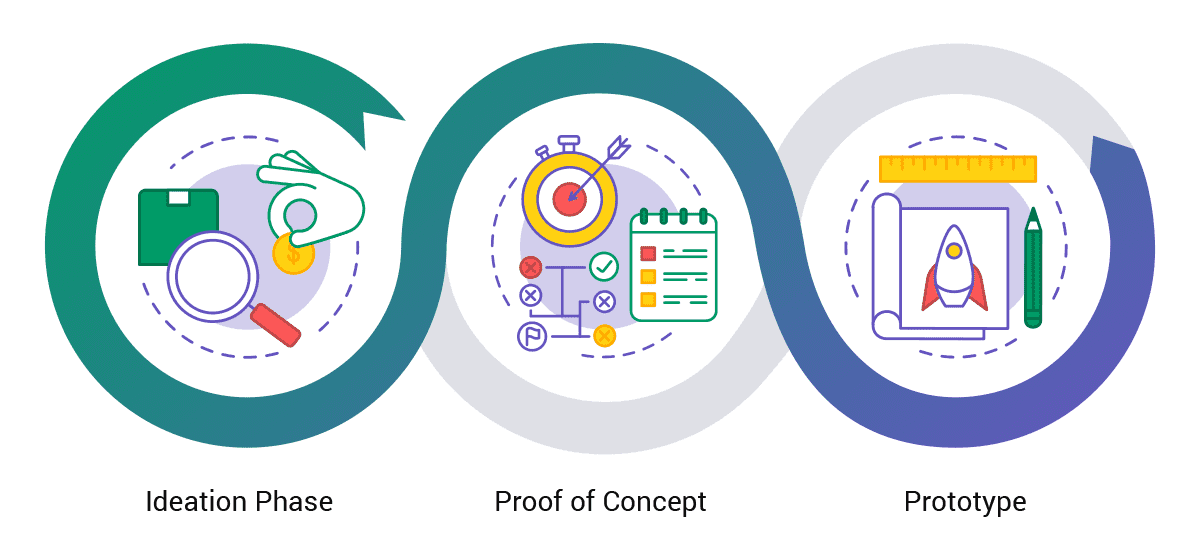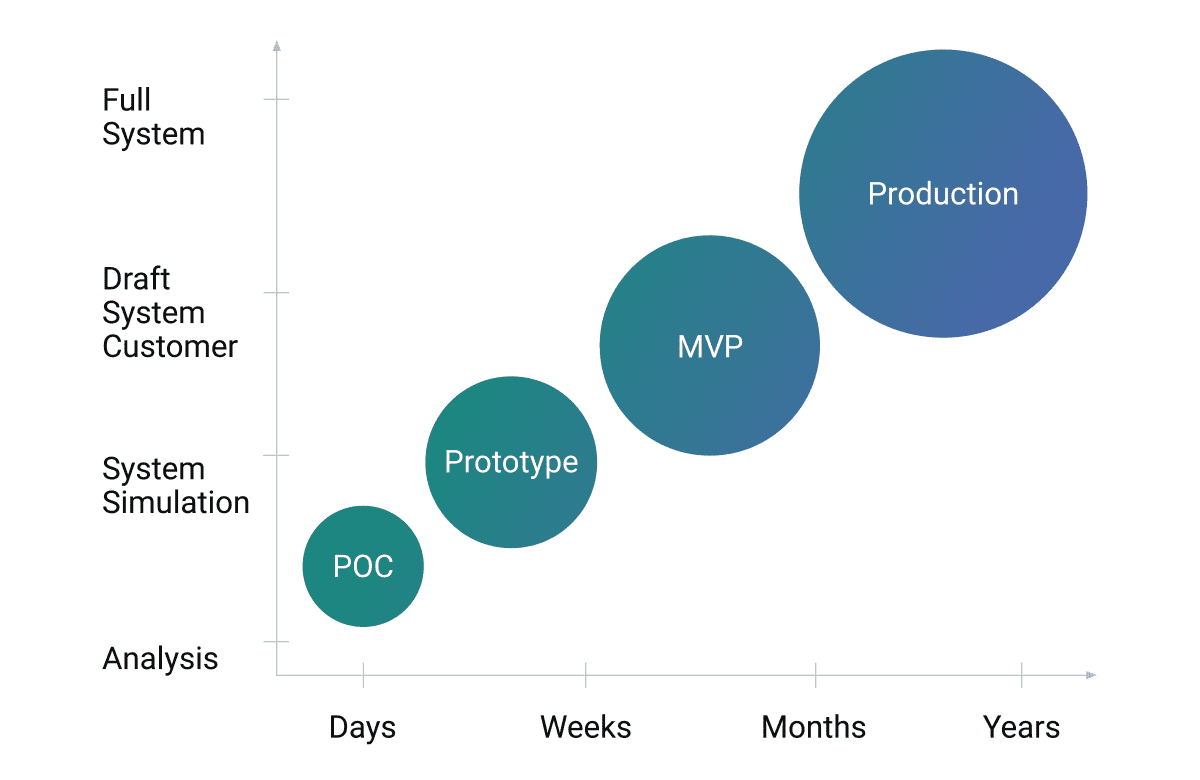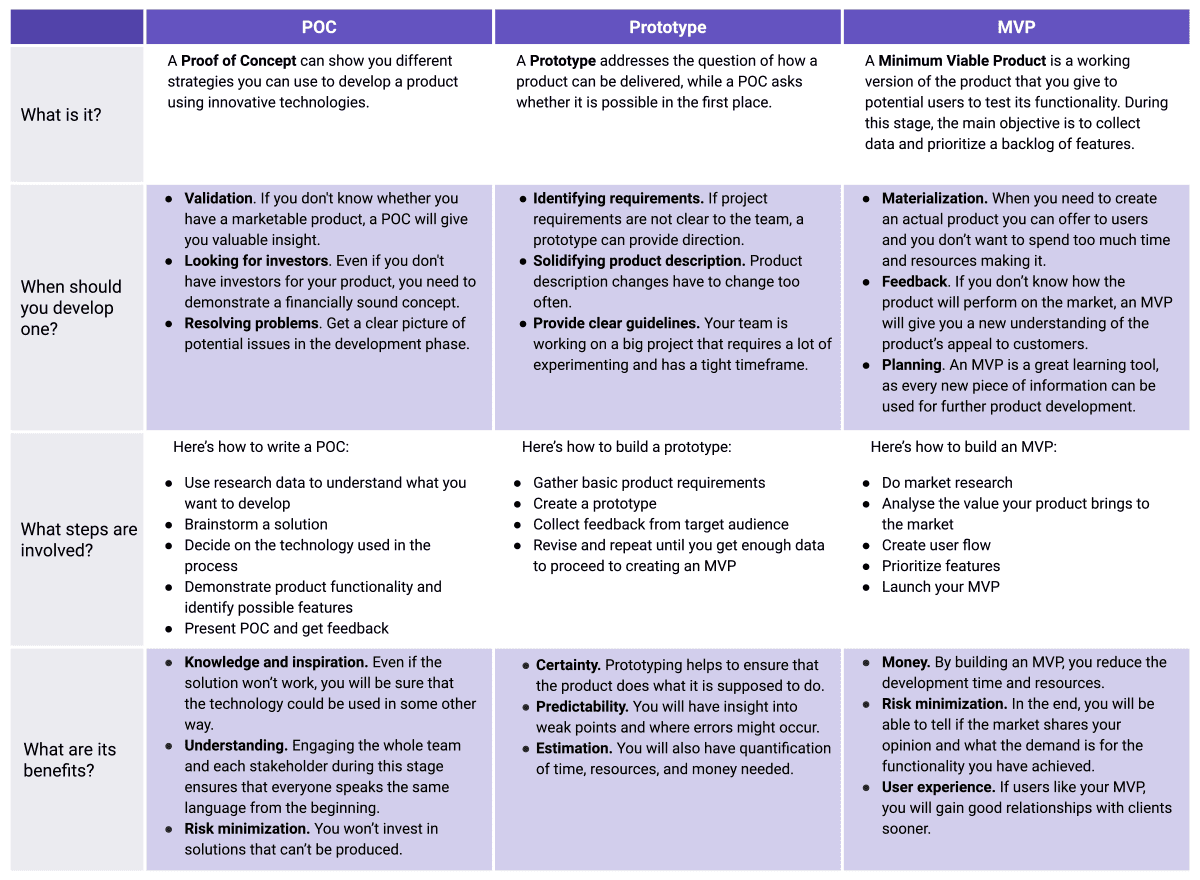Updated: 5/7/2024
You have an excellent idea but don’t know what to do with it? New app or service—how much do you need to build in order to show investors, get potential clients on board, or just to start selling? Speculators, technology bloggers, early adopters, journalists—how to get the interest of all these individuals? What is going to separate your company from the crowd?
It's hard to decide. It sounds like you might need a proof of concept, prototype, or minimum viable product. At Softjourn, we understand the need for all these types of solutions and know that each minimizes the time and cost of implementation.
So let’s start from the top.

What is the Ideation Phase?
Ideation is the process of generating new ideas and solutions. It is a creative process that allows your team to transition from identifying problems to developing solutions. In the project discovery phase, ideation allows you to think differently about new software concepts.
By asking the right questions in the ideation phase, your team can bring together new perspectives and step beyond an obvious, single solution. Ideation facilitation is important in a Design Thinking approach as it guides the team towards innovation.
What is a Proof of Concept?
A technical POC, or Proof of Concept, is a small-scale demonstration or project that verifies the feasibility of a specific technical idea, method, or technology.
Once a team focuses on the technology, they can assess whether the product is feasible or has potential limitations. A POC can help you with:
- Validate that a concept or theory can be implemented in practice
- Explore potential technical challenges or limitations
- Demonstrate the viability of a solution to stakeholders
- Gather feedback and insights for further development
POCs are typically limited in scope, focusing on core functionality rather than a complete product. They're often used in software development, IT projects, and other technical fields to reduce risks before committing to full-scale implementation.
With a successful POC, project managers can see whether a product meets customers’ needs to ensure the best possible process outcome. Regardless of a POC's short life cycle, shareholders will be able to decide whether the idea is worth developing.
Here’s how to write a satisfactory proof of concept:
- Use research data to understand what you want to develop
- Brainstorm a solution
- Decide on the technology used in the process
- Demonstrate product functionality and identify possible features
- Present POC and get feedback
When Do You Need a Proof of Concept?
A POC varies greatly depending on the product type and the development phase's complexity. Behind every POC, there is comprehensive research and assessing one or more key aspects of what might be involved in a production system.
After data analysis, we know which tools we need to develop for a fully functioning solution and have input on setting out a project plan and timetable.
Here's when you need a POC:
- Validation. If you don't know whether you have a marketable product, a POC will give you valuable insight.
- Looking for investors. Even if you don't have investors for your product, you need to demonstrate a financially sound concept.
- Resolving problems. Get a clear picture of potential issues in the development phase.
What are the Benefits of a Proof Of Concept?
Here’s how can a proof of concept can benefit you:
- Knowledge and inspiration. Even if the solution won’t work, you will be sure that the technology could be used in some other way.
- Understanding. Engaging the whole team and each stakeholder during this stage ensures that everyone speaks the same language from the beginning.
- Risk minimization. You won’t invest in solutions that can’t be produced.
A successful POC involves identifying a specific problem or need, researching potential solutions, and testing those solutions to see if they are viable. To create a successful POC, it's important to define clear goals and requirements, choose the right technology, test and validate the product, and collect feedback from stakeholders and users.
Proof of Technology vs. Proof of Concept
Proof of Technology (POT) and POC are terms used interchangeably to describe testing an idea to see whether the technology used can support project goals.
Once your product passes through ideation stages and you gain valuable feedback, it is time to determine whether the product is viable. Both POTs and POCs help developers to define clear input and output flows and get a general view of the product's layout.
| Key Differences Between PoT and PoC | ||
| Aspect | Proof of Technology (PoT) | Proof of Concept (PoC) |
| Objective | To test and validate the technical feasibility of a technology | To demonstrate that a proposed solution can solve a specific problem |
| Focus | Technology-centered | Solution-centered |
| Stage of Development | Early-stage research and development | Advanced stages of research and development |
| Scope | Narrow, often focused on a single technology component | Broader, encompassing the entire solution |
| Outcome | Identification of viable technologies | Validation of the proposed solution's effectiveness |
Building a POT will provide you with data that shows how to move forward with the product. You can stay on your initial course or change your focus depending on the findings you've gathered in this stage of development.
What Comes After Proof of Concept?
After a successful Proof of Concept (POC), several stages typically follow in the product development lifecycle. Here's an overview of what often comes after a POC:
- Prototype:
- A more refined version of the POC
- Demonstrates the product's core functionality
- Often used for internal testing and stakeholder presentations
- Minimum Viable Product (MVP):
- The first version released to users
- Contains core features to solve the main problem
- Used to gather real-world feedback
- Beta Version:
- A more complete product with most planned features
- Released to a limited user group for testing
- Helps identify bugs and usability issues
- Full Product Development:
- Building out all planned features
- Incorporating feedback from earlier stages
- Focusing on scalability and robustness
- Launch:
- Official release of the product to the market
- Often accompanied by marketing efforts
- Iterative Improvement:
- Continuous updates based on user feedback and market demands
- Adding new features and refining existing ones
The exact path may vary depending on the product, industry, and development methodology. Some organizations might skip certain stages or combine them, adapting the process to their specific needs and constraints.
What is a Prototype?
A prototype is another way to test the viability of your concept. A prototype addresses the question of how a product can be delivered, while a POC asks whether it is possible in the first place.
A prototype brings your idea to life. A development team can create a layout and most of the product's functionalities to access its performance.
The purpose of a prototype is to transform a complex idea into a product by allowing users to interact with it. Every conclusion you acquire from this process will guide later product development cycles.
Here are the steps to build a successful prototype:
- Gather basic product requirements
- Create a prototype
- Collect feedback from target audience
- Revise and repeat until you get enough data to proceed to creating an MVP
When Do You Need a Prototype?
You know that the solution can be developed but you are not sure how to do it?
A prototype is what you need. Before creating a prototype, we define input and output flows and provide an idea of the layout. We can gain greater knowledge of what the solution of the POC will be when finalized: product usability, functionality, and design.
You need a prototype when:
- Identifying requirements. Project requirements are not clear to the team.
- Solidifying product description. Product description changes have to change too often.
- Provide clear guidelines. Your team is working on a big project that requires a lot of experimenting and has a tight timeframe.
What are the Benefits of a Prototype?
Benefits of a prototype include:
- Certainty. Prototyping helps to ensure that the product does what it is supposed to do.
- Predictability. You will have insight into weak points and where errors might occur.
- Estimation. You will also have quantification of time, resources, and money needed.
A successful prototype involves bringing your idea to life and testing its performance with users. To create a successful prototype, you should gather basic product requirements, create a visual design and clickable demo, collect feedback from target audiences, and revise and repeat until you have enough data to proceed to the next stage.
| Proof of Concept (PoC) vs Prototype | ||
| Proof of Concept (PoC) | Prototype | |
| Purpose | To validate the feasibility of an idea or concept | To demonstrate how a product or feature would work in the real world |
| Scope | Narrow, focuses on a single aspect or functionality of the product | Broad, covers multiple aspects of the product |
| Depth | Shallow, validates if an idea can be turned into a viable product | Deep, shows the look and feel of the final product, may even have some functionality |
| Audience | Primarily internal teams like stakeholders or developers | Both internal teams and external entities like investors, testers, or potential customers |
| Outcome | Determines whether the idea is worth pursuing further | Serves as a working model for the final product, used to refine requirements and receive user feedback |
What is a Minimum Viable Product?
One of the best ways to examine whether a product is ready to go to market is by building a minimal viable product (MVP) with basic functionality.
An MVP is a working version of the product that you give to potential users to test its functionality. During this stage, the main objective is to collect data and prioritize a backlog of features.
Also, it is crucial to decide which product features to focus. This allows you to reduce risks and maximize return in the future development stages.
Here are the steps to build an MVP:
- Do market research
- Analyse the value your product brings to the market
- Create user flow
- Prioritize features
- Launch your MVP
When Do You Need an MVP?
You have a prototype but are wondering if the market really needs it?
The only way to check it without spending lots of money is to prepare an MVP that provides only the minimum functionality and can be confronted with a group of potential users.
During this stage, the work is focused on business functions. Moreover, you will be forced to define your value precisely and decide what really needs to be developed to test this value.
Here’s when you need an MVP:
- Materialization. When you need to create an actual product you can offer to users and you don’t want to spend too much time and resources making it.
- Feedback. If you don’t know how the product will perform on the market, an MVP will give you a new understanding of the product’s appeal to customers.
- Planning. An MVP is a great learning tool, as every new piece of information can be used for further product development.
What are the Benefits of an MVP?
Advantages of an MVP include:
- Money. By building an MVP, you reduce the development time and resources.
- Risk minimization. In the end, you will be able to tell if the market shares your opinion and what the demand is for the functionality you have achieved.
- User experience. If users like your MVP, you will gain good relationships with clients sooner.
A successful MVP involves launching a basic version of your product that provides enough value to attract early adopters and collect feedback. To create a successful MVP, you should do market research, analyze the value your product brings to the market, create a user flow, prioritize features, and launch your MVP.

POCs, prototypes, and MVPs provide cost-effective and time-saving alternatives before delving straight into production.
Proof of Concept (POC) vs Minimum Viable Product (MVP)
Proof of Concept (POC) and Minimum Viable Product (MVP) are two crucial stages in product development, each serving distinct purposes in the innovation process. While often confused, these concepts differ significantly in their objectives, scope, and implementation.
A Proof of Concept is primarily a technical exercise aimed at validating the feasibility of a specific idea or technology. It answers the fundamental question: "Can this be done?" POCs are typically developed rapidly, focusing on core functionalities without concern for scalability or user experience. They're internal tools, rarely seen by end-users, and serve to mitigate technical risks before significant resources are committed.
In contrast, a Minimum Viable Product represents the earliest stage of a functional product that can be released to users. It addresses the question: "Should this be built?" An MVP includes just enough features to satisfy early customers and provide feedback for future development. Unlike a POC, an MVP is designed with the end-user in mind, offering a basic but coherent user experience.
The key differences can be summarized as follows:
- Purpose: POCs validate technical feasibility, while MVPs test market viability.
- Audience: POCs are typically for internal stakeholders, whereas MVPs target early adopters or potential customers.
- Scope: POCs have a narrow focus on specific technical aspects, while MVPs offer a broader, albeit basic, product experience.
- Functionality: POCs demonstrate technical concepts, often in isolation. MVPs provide a cohesive set of core features that solve a user problem.
- Refinement: POCs are often rough and unpolished, while MVPs require a certain level of polish to be usable by customers.
- Timeframe: POCs are usually short-term projects, while MVPs often evolve over time based on user feedback.
- Outcome: A successful POC leads to further development or an MVP, while a successful MVP guides product evolution and scaling.
In the product development lifecycle, a POC often precedes an MVP. Once technical feasibility is established through a POC, teams can confidently move to develop an MVP, incorporating learnings from the POC stage. This approach helps organizations minimize risks, optimize resource allocation, and increase the chances of market success.
Understanding the distinction between these concepts is crucial for product managers, developers, and stakeholders. It ensures that the right approach is chosen at each stage of development, aligning technical capabilities with market needs and business objectives.
Cheat Sheet for Deciding Between POC, Prototype, and MVP
These three approaches can be used to validate a product quickly and less expensively. Each method has advantages when used to test business concepts early or win over stakeholders.
To better understand the differences between POC, Prototype, and MVP, let's consider some examples.
A POC for a new payment platform might involve building a basic version of the platform to test if the payment technology works.
A prototype for a new social media app might involve creating a visual design and clickable demo of the app's main features.
An MVP for an e-commerce website might involve launching a basic version of the site that allows users to browse and purchase products without any extra features or functionality.
Go for POC if:
- You need a seed-stage funding
- You need to check whether the technical aspects of the idea work
- You want to share information within your team
Go for Prototype if:
- You need to visualize your product and show it to stakeholders and potential investors
- You have limited resources
Go for MVP if:
- You have to monetize your product quickly
- You have to show a working app to future customers

What's the Best Approach for You?
Validating an idea and choosing the right tech stack can make or break your project. These decisions directly affect every stage of development, so choosing the right path is important! Once you understand how POC, POT, prototypes, and MVPs work, it is easier to decide which is right for your project.
Softjourn is a global technology services provider that helps clients find custom solutions to their toughest challenges. We leverage our domain expertise in Fintech, Cards & Payments, and Media & Entertainment to bring our clients' growing needs to life.
Our team of experts can guide you through the ideation process, help you choose the right approach for your product, and provide ongoing support as you move from POC to Prototype to MVP and beyond. Contact us today to learn more.










